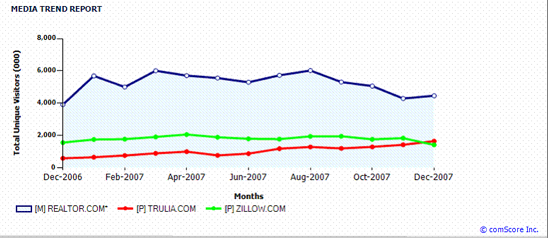 Real-estate site Zillow has added 10 million homes to its Website, bringing the total to 80 million (out of 91 million homes in the U.S.). Of those, the properties it has enough information on to calculate a “Zestimate” is now 67 million, up from 53 million before. Zestimates and comparable-sales data are the two biggest draws to the site, says president Lloyd Frink, who dropped by my office on Wednesday.
Real-estate site Zillow has added 10 million homes to its Website, bringing the total to 80 million (out of 91 million homes in the U.S.). Of those, the properties it has enough information on to calculate a “Zestimate” is now 67 million, up from 53 million before. Zestimates and comparable-sales data are the two biggest draws to the site, says president Lloyd Frink, who dropped by my office on Wednesday.
I gave Frink a hard time because I always find the Zestimates for properties in New York City to be way off base. “New York is tough,” he admitted. But Zillow has tweaked its algorithm and improved the accuracy of its Zestimates by 12 percent (as measured by the actual sale price versus the last Zestimate on the day of the sale).
The algorithm improved by diving deeper into the data. “We went from having a model for each county to 20 models for each county,” says Frink. The Zestimates also now take into account more than one million corrections and facts added by home owners. The margin of error is now 8.8 percent. That is an average for the entire country. You still can’t trust the Zestimates on New York City apartments. But Frink notes that a third of the site’s Zestimates across the country fall within five percent of the selling price, and that half are within 10 percent. Still, he cautions that “the Zestimate is just a starting point.”
You’d think that real-estate sites would be hurting right now, given the severe correction in the housing market. But Frink argues that in a down market research is more important than ever and says that Zillow is still benefiting from the overall shift in real estate activities to the Web. Zillow’s ad model certainly benefits from various targeting capabilities-geographic, demographic, and behavioral. Each action on the site is zipcode-specific. Frink notes that the EZ Ads Zillow sells itself go for $10 CPMs, versus $3 to $5 CPMs for backfill ads from ad networks.
Zillow is trying to create a database of all homes in the U.S., which is a different approach than other real-estate sites. “It is the database of all homes, not just homes on the market,” notes Frink. This is both a strength and a weakness. On the downside, Zillow lists only 400,000 homes that are for sale, out of about 4 million nationwide. A deal with real-estate publisher Network Communications will bring that total to 900,000. Trulia, in comparison, has 2 million.
On the upside, Zillow has a lot more comparable data than most sites. (Although, I think Cyberhomes has better data). And since Zillow lists all existing homes, it makes it easy to provisionally put your house on the market through its “Make Me Move” feature. About 100,000 Make-Me-Move homes are on the site. And in some markets, it is a pretty significant number. For instance, in Seattle (where Zillow is based), there are 30,000 homes officially for sale and another 6,000 Make-Me-Move listings, or 20 percent of the number on the market.
The other big news is that Zillow is joining Yahoo Real Estate, Trulia, Oodle, Homes.com, Realestate.com, Vast.com and others in adopting a standard way for brokers and multiple listings services (MLSs) to send in their real estate listings in a feed format. That way brokers can use the same data format for all the different real estate search engines and Websites. It is called the Real Estate Transaction Standard (RETS). [Correction: RETS is actually a different, pre-existing, standard that the new listing feed standard will interoperate with]. That should make it easier for brokers to propagate their listings everywhere.
Zillow claims 4 million monthly unique visitors. Comscore shows 1.4 million in December, and that’s been flat for the past year. Trulia, though, looks like it just passed Zillow with 1.6 million.
